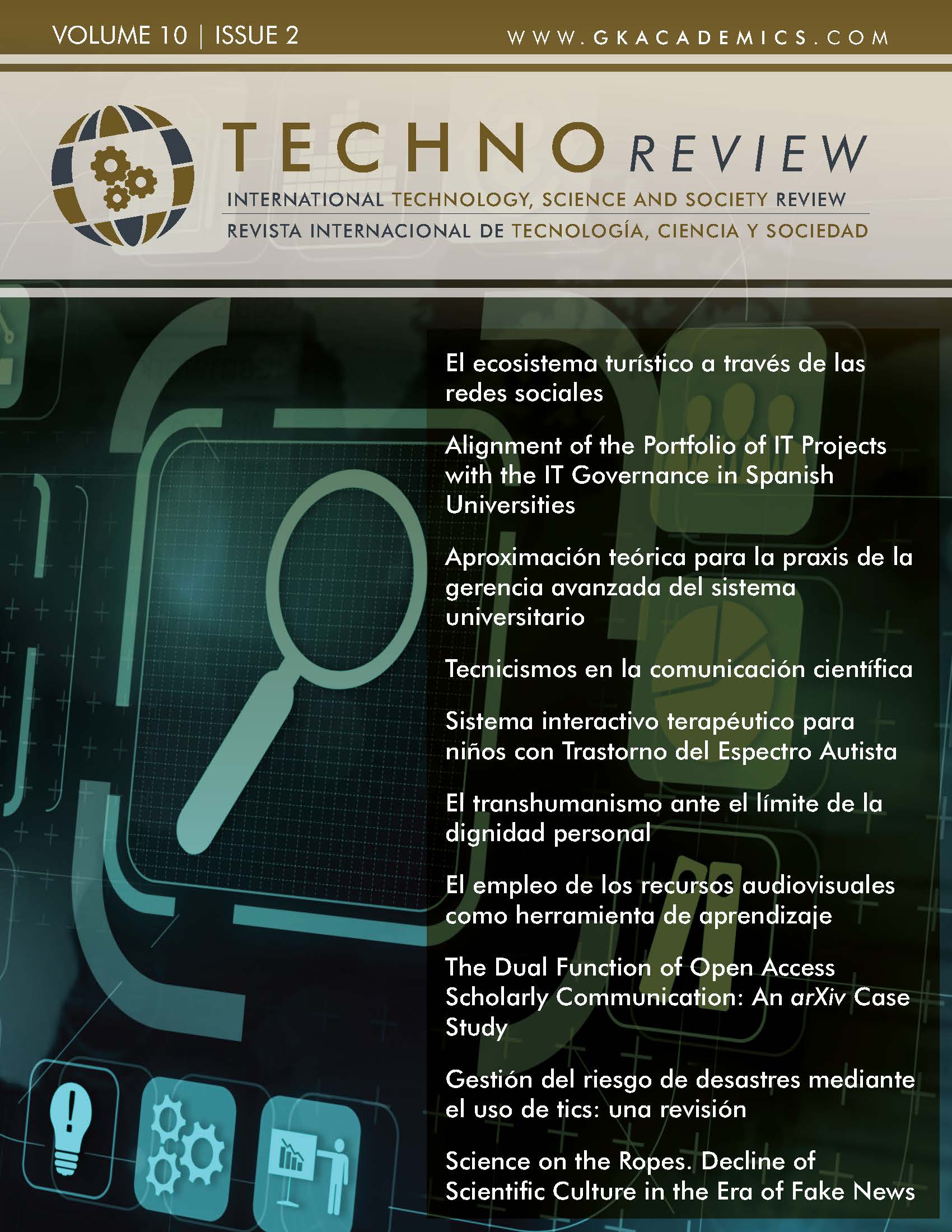Interactive Therapeutic System for Children with Autistic Spectrum Disorder
DOI:
https://doi.org/10.37467/gka-revtechno.v10.3003Keywords:
Autism, Robotics, Interface, Training, Therapeutic, SoftwareAbstract
This project focuses on children with autism (scientifically called Autism Spectrum Disorder - ASD). It presents an interactive system whose main objective is to help the development of social and motor skills through the accompaniment of the Bioloid robot in humanoid configuration, which is programmed to interact with training routines oriented to physical activity, communication, and socialization.
References
Abad-Sacoto, K., Sánchez-Delgado, M. A., Crespo-Cedeño, J. E. y Alvarado-Chang, J. E. (2017). Sistemas de reconocimiento en la robótica social. Revista de Ciencia, Tecnología e Innovación, 4(3). EPISTEME.
Asociación Estadounidense de Psiquiatría. (2014). Manual de diagnóstico y estadístico de los trastornos mentales (DSM5) (5ª ed.). Madrid: Panamericana.
Ayres, J. (1972). Sensory integration and learning disorders. Los Angeles: Western Psychological Services.
Beaudry, I. (2006). Un trastorno en el procesamiento sensorial es frecuentemente la causa de problemas de aprendizaje, conducta y coordinación motriz en niños. Boletín de la sociedad de pediatría de Asturias, Cantabria, Castilla y León, 46, 200-203.
Benton, L., & Johnson, H. (2014). Structured approaches to participatory design for children: can targeting the needs of children with autism provide benefits for a broader child population? Instructional Science, 42(1), 47-65.
Bogdashina, O. (2016). Sensory Perceptual Issues in Autism and Asperger Syndrome. Different Sensory Experiences - Different Perceptual Worlds (Second Edition). Jessica Kingsley Publishers.
Coleman, M. (1996). Autism and medical disorders: a review of the literature. Dev Med Child Neurol, 38, 191-202.
Confederación Autismo España (2014). Sobre el TEA. (2014). Disponible en: http://www.autismo.org.es/sobre-los-TEA/deteccion
De Rozental, L. (1993). El autismo: enfoque fonoaudio-lógico. Editorial Médica Panamericana.
Dickstein-Fischer, L. & Fischer, G. S. (2014). Combining psychological and engineering approaches to utilizing social robots with children with Autism. Annual International Conference of the IEEE Engineering in Medicine and Biology Society. IEEE Engineering in Medicine and Biology Society, 792-795. https://doi.org/10.1109/EMBC.2014.6943710.
Educación 3.0 (2020). Home [página de Educación 3.0]. https://www.educaciontrespuntocero.com/opinion/robotica-social/
Fernández, S. (2009). Locomoción bípeda del robot humanoide Nao [Trabajo final de Carrera, Universitat Politècnica de Catalunya]. http://hdl.handle.net/2099.1/9115
Flipkart, (2019). SainSmart 17-Dof Biped Humanoid. www.flipkart.com/sainsmart-17-dof-biped-humanoid-kit-sr319-digital-servos-controller/p/itmf3h46qys4fpha
Fuentes-Biggi, J., Ferrari-Arroyo, M.J., Boada-Muñoz, L., Touriño-Aguilera, E., Artigas-Pallarés, J., Belinchón-Carmona, M., Muñoz-Yunta, J.A. , Hervás, A., Canal-Bedia, R., Hernández, J.M., Díez-Cuervo, A., Idiazábal-Alecha, M. A., Mulas, F., Palacios, S., Tamarit, J., Martos-Pérez, J. y Posada-De la Paz, M. (2006). Guía de buena práctica para el tratamiento de los trastornos del espectro autista. Revista de Neurología, 43(7),425-438. DOI: https://doi.org/10.33588/rn.4307.2005750
Garnica, E., Quiroga, B., Miranda, P., y Medina, Á. (2016). Diseño de módulos interactivos para tratar el trastorno por déficit de atención con hiperactividad - TDAH. Revista Ingeniería, Matemáticas y Ciencias de la Información, 3(6). Disponible en: http://dx.doi.org/10.21017/rimci.2016.v3.n6.a14
Garrabé, J. (2012). El autismo. Historia y clasificaciones. Salud Mental. 35(3):257-261. Recuperado de https://www.medigraphic.com/pdfs/salmen/sam-2012/sam123j.pdf
Gebhart, A. (2018). Ubtech Robotics Lynx review. https://www.cnet.com/reviews/ubtech-robotics-lynx-review/
González, O. (2016). ZEUS: el robot humanoide hecho con Arduino y Raspberry Pi. Brico Geek. https://bit.ly/3a1Pdj8
Heimann, M., Nelson, K. E., Tjus, T., Gillberg, C. (1995). Increasing reading and communication skills in children with autism thought an interactive multimedia computer program. Journal of Autism and Developmental Disorders, 25(5): 459-480.
HOAP. (2012). En Gaz. Wiki. https://gaz.wiki/wiki/es/HOAP#
L’Ecuyer, C. (2015). La estimulación temprana fundamentada en el método Doman en la educación infantil en España: bases teóricas, legado y futuro [The Doman method applied to early learning in Spain: theoretical bases, legacy and future]. ENSAYOS. Revista de la Facultad de Educación de Albacete, 30(2), 137-153. https://doi.org/10.18239/ensayos.v30i2.890
Liga Colombiana de Autismo (2020). ¿Qué es el TEA?. Disponible en: https://ligautismo.org/que-es-el-tea/
Mesibov, G. B., & Shea, V. (2010). The TEACCH program in the era of evidence-based practice. Journal of Autism and Developmental Disorders, 40(5), 570-579.
MIDLAND (2016). ALPHA 1S. www.midland.es/robotica/527-alpha-1s.html.
Montero-González, P. (2003). Sistemas alternativos y aumentativos de Comunicación (SAAC) y accesibilidad - Bases teóricas de los saac. Puertas a la lectura, 4, 129-136. https://dialnet.unirioja.es/servlet/articulo?codigo=6023011
Morin, A. (2014). Terapia de integración sensorial: Lo que necesita saber. Understood. https://www.understood.org/es-mx/learning-thinking-differences/treatments-approaches/therapies/sensory-integration-therapy-what-you-need-to-know
Mulas, F., Ros-Cervera, G., Millá, M. G., Etchepareborda, M. C., Abad, L. y Téllez de Meneses, M. (2010). Modelos de intervención en niños con autismo. Revista de Neurología, 50(3), 77-84.
NIH Instituto Nacional de Salud Infantil y Desarrollo Humano (2020). Trastorno del espectro autista de MedlinePlus. Sitio web: https://medlineplus.gov/spanish/autismspectrumdisorder.html
OMS Organización Mundial de la Salud (2019). Trastornos del espectro autista de OMS. Sitio web: https://www.who.int/es/news-room/fact-sheets/detail/autism-spectrum-disorders
Porcelli, A. M. (2020). La inteligencia artificial y la robótica: sus dilemas sociales, éticos y jurídicos. Derecho global. Estudios sobre derecho y justicia, 6(16), 49-105. https://doi.org/10.32870/dgedj.v6i16.286
Rivera, G. (2014). Trastorno del espectro del autismo. Diagnóstico, 53(3), 142-148.
Rapin, I. (1997). Autism. The New Journal of Medicine, 337(2), 97-104.
Ribes I., (1972). Terapias conductuales y modificación del comportamiento Revista Latinoamericana de Psicología, 4(1), 7-21. Fundación Universitaria Konrad Lorenz.
Robotrónica. (2015). Nao. Los robots del futuro son ya una realidad. https://aliverobots.com/nao/
RO-BOTICA (2017). Kit ROBOTIS PREMIUM - KidsLab. https://ro-botica.com/Producto/ROBOTIS-PREMIUM-Kit-educativo-Bioloid/
RO-BOTICA (2017b). EDBOT DARWIN MINI. https://ro-botica.com/tienda/ROBOTIS_KidsLab/EDBOT/
Robotis. (2018). Bioloid [Imagen]. Robotis Store. https://robotis.us/
Rodríguez, J. P. C. y Pico, L. E. A. (2016). Un análisis del autismo desde la perspectiva de su influencia en familias y la tecnología como facilitador en el manejo de esta condición. Revista Logos, Ciencia & Tecnología, 8(1), 168-182.
Sánchez-Martín, F.M., Jiménez, P., Millán, F., Salvador-Bayarri, J., Monllau, V., Palou, J. y Villavicencio, H. (2007). Historia de la robótica: de Arquitas de Tarento al Robot da Vinci. (Parte II). Actas Urol Esp., 31(3), 185-196. https://scielo.isciii.es/pdf/aue/v31n3/v31n3a02.pdf
Sinha, Y., Silove, N., Hayen, A., & Williams, K. (2011). Auditory integration training and other sound therapies for autism spectrum disorders (ASD). The Cochrane Database of Systematic Reviews, 2011(12).
Talero, C., Martinez, L., Mercado, M., Ovalle, J. P., Velásquez, A. y Zarruck J.G. (2003). Autismo: estado del Arte. Rev. Cienc. Salud, 1(1), 68-85. http://www.scielo.org.co/ https://doi.org/10.1002/14651858.CD003681.pub3pdf/recis/v1n1/v1n1a7.pdf
Downloads
Published
Issue
Section
License
All articles are published under an Attribution-NoDerivatives 4.0 International (CC BY-ND 4.0) license. Authors retain copyright over their work.

